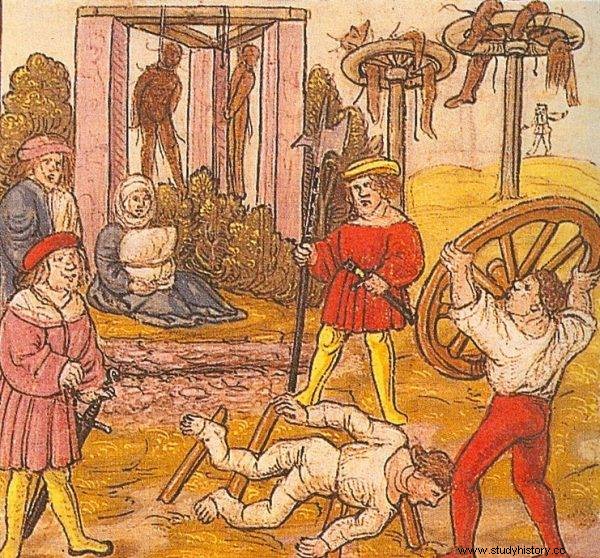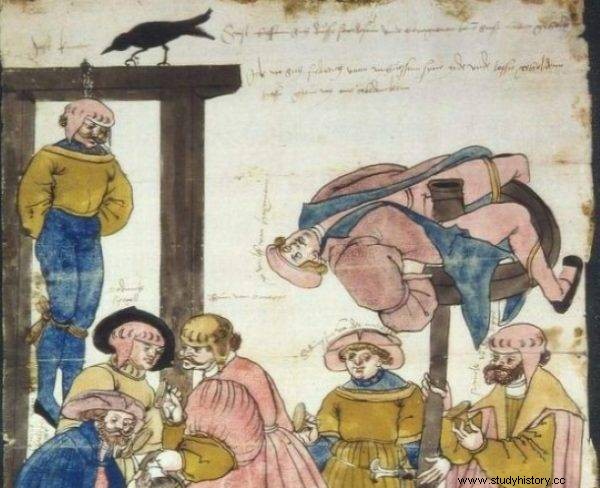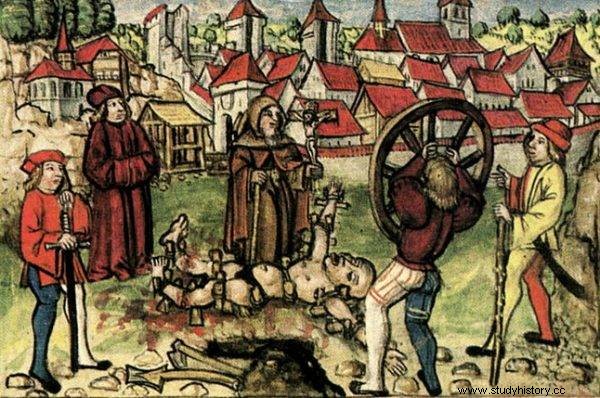Breaking the wheel allowed to decide exactly how long the penalty will last. On top of that, it was extremely painful - and spectacular. Record holders died in torment even for several days.
This sophisticated and extremely cruel torture was the specialty of the Germanic states of the Holy Roman Empire. However - more or less frequently - it was used throughout Europe.
In some places, breaking the wheel as a method of execution was still in use in the 18th century. What was it about? Jonathan J. Moore writes:
First the executioner tied the delinquent to the big cart wheel, making sure that the limbs were level with the gaps between the spokes . Then, with the help of a specially prepared heavy metal bar, began to break each limb one by one In a few places.
Since the role of the executioner was to extend the life of the condemned man in accordance with the verdict of the city or ducal court, he had to be careful not to damage the most important organs and minimize blood loss.

First, the executioner tied the guy to the big cart wheel, making sure that the limbs were level with the gaps between the spokes.
How did it work in practice? Probably first the executioner with a pole (or, alternatively, a second, smaller circle) smashed the condemned's femurs and shoulder bones, then the shinbones and wrists (here the risk of bleeding was greater, as bone fragments could pierce the skin) . Then it was time for the knees, elbows, hands ... The pain the victim felt was unimaginable.
Read also:Breaking with a wheel, gallows, pile driving - how were punished in old Poland?
Top or bottom?
There were two kinds of breaking the wheel - both equally cruel, though one was a bit more humane. Namely, breaking "from above", during which the convict received a blow to the head from the very beginning . At best, he was dying before the executioner started crushing bones. At worst, he was losing consciousness.
This is better than the "bottom-up" alternative. As described by Jonathan J. Moore:
Breaking "from the bottom" was to extend life and cause as much suffering as possible . One by one, the feet, legs, hands and arms were broken, and only then was finally a fatal blow to the head or neck.

In some places, breaking the wheel as a method of execution was still in use in the 18th century.
The court very precisely determined which of the above methods should be applied in a specific case. The idea was for the punishment to be adequate to the crime committed. But not only that.
The executioner's remuneration depended on the type of execution - upfront service was cheaper . For example, in the 18th century in Serbia, the torturer received 18 florins for her. He already collected 20 for breaking "from the bottom", so the choice of the procedure also depended on the wealth of the municipal cash register.
Read also:How to torture and then ... heal? Medieval rehabilitation after visiting the torture chamber
The grace of death
Breaking a wheel was used as a punishment not only because of its cruelty, but also the fact that it was possible to determine exactly how long the torment would last - and at the same time make it a public spectacle for the crowd hungry for macabre entertainment.
For example, in 1762 a French court sentenced the merchant Jean Calas (accused of murdering his own son) to two hours of torture, culminating in a coup de grâce - a blow of grace. It happened, however, that a skilled executioner, commissioned by judges, delayed the execution even up to several days!

The pain the victim felt was unimaginable.
When the time of harassing the condemned, specified in the sentence, passed, the victim was killed in various ways. It could have been a few blows to the chest at the level of the heart, or - if there was a need for a more spectacular death - beheading with a special circle with a crescent-shaped blade. Jonathan J. Moore reports:
at the end of the performance with the same blade the corpse was quartered, and then the steaming debris was placed on a wheel and this macabre composition was placed on a pole so that everyone can get a good look.
Sometimes before lifting the wheel , jelly-like limbs were interspersed through the gaps between the spokes, and the head was hammered onto a pin attached to the hub. (...) Undoubtedly, many passers-by, seeing something like this, decided to rethink their actions in order to avoid a similar fate.
Read also:Klatka dla Brzuchatego - the cruelest torture from the times of the Piasts
Every country is a custom
Of course, there were local variations of wheel breaking. For example, in France, a court of goodwill could add retentum - to the judgment a special clause to strangle the victim after only one or two blows.
On the other hand, in Turkey, Russia and several other Eastern European countries the convict had nothing to dream of a quick death. On the contrary, the torture was even more sophisticated there. After crushing the bones with a wooden hammer, the victim's limbs were twisted even 180 degrees and then wrapped them around the spokes of the wheel.
The wheel itself was placed on a high stake, and the unfortunate man would die for hours in torment, which only aggravated the birds pecking at his eyeballs ...
Traces on the bones
In 2019, Italian archaeologists from the University of Milan revealed the case of a medieval man who was most likely sentenced to death by breaking a wheel in the 13th century. An analysis of his skeleton revealed that he was young at the time of his execution - he could have been 17 to 20 years old.

There were two kinds of breaking the wheel - both equally cruel, though one was a bit more humane.
The use of this extremely cruel method of execution was indicated by bone fractures placed symmetrically on the victim's arms and legs. If this was the case, the Milan find is the first archaeologically documented case of an execution by breaking a wheel . The immediate cause of death was to be an incompletely beheading.
Typically, breaking the wheel was the punishment provided for the most heinous crimes (e.g. murder), but in northern Italy it was also used against people suspected of spreading the plague . And that was probably the case with the man in question. As the researchers write:
The victim could be regarded by her contemporaries simply as different. Perhaps it was the discrimination that led to the conviction. For the man could have been "sacrificed" by an enraged mob as a "weirdo" and plague sower.
As you can see, in the Middle Ages it didn't take much to "deserve" an extremely slow and painful death, so it was better to be on your guard.
Bibliography:
- B. Innes, History of Torture , Bellona 2000.
- D. Mazzarelli, D. Gibelli et al., First signs of torture in Italy:A probable case of execution by the wheel on a skeleton from 13th century Milano , "Journal of Archological Science" vol. 109, September 2019.
- J. J. Moore, Hang, gut and dismember , Horizon 2019 sign.
- S. Wrzesiński, Bloody profession. About the executioners and their victims , Libron 2006.
